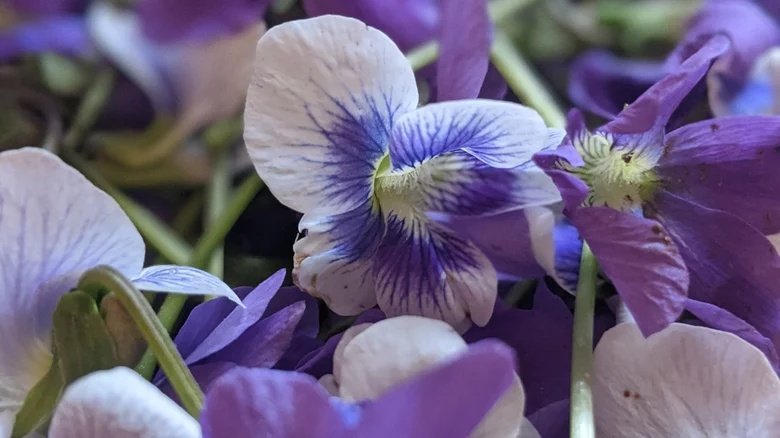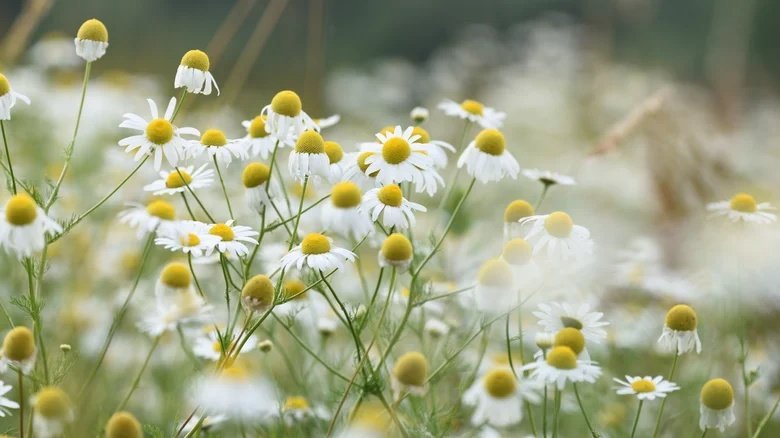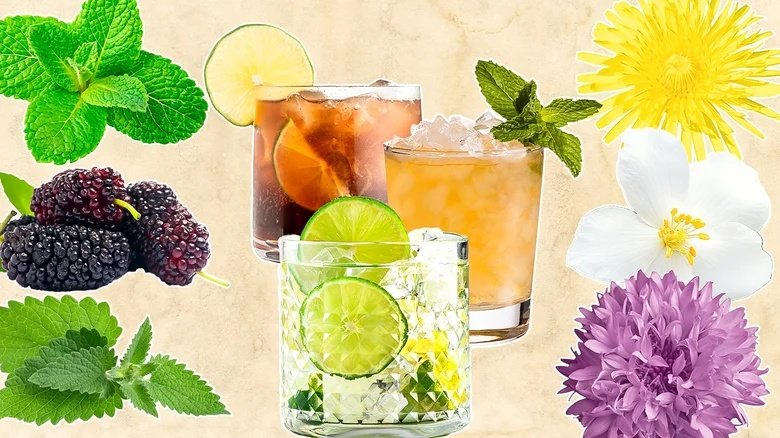In the season of spring’s reawakening, when nature’s vegetation flourishes and renews, it presents an opportune moment to procure this natural abundance for the concoction of homemade cocktails. Incorporating wild-grown floral, herbal, and other botanical adornments not only imparts a visually captivating charm to spring cocktails, but also infuses them with an invigorating array of fragrances and flavors that stimulate the senses. (For additional inspiration, peruse our suggestions for winter drink garnishes as well.)
However, it’s crucial to go over some crucial guidelines for eating wild edible plants before you go foraging for them. Since many plants have toxic lookalikes, accurate identification is crucial. To prevent any dangerous errors, think about using a trustworthy field guide or speaking with an expert unless you are absolutely certain of what you are collecting. After that, make sure to wash your harvest well and only gather from hygienic, pesticide-free areas. Before using wild plants, thoroughly rinse them because they may contain insects, dirt, and debris.
In light of this, we offer you 18 brand-new garnishes that will elevate your springtime cocktails. They are created using edible flowers and other wild plants. With the help of these garnishes, you can add beauty, fragrance, and flavors that perfectly encapsulate the season and elevate your cocktail hour.
Wild violets

Rainy soils and shady spots are ideal for wild violet growth. Almost any type of habitat can support them, including bogs, wetlands, dry meadows, rocky outcroppings, city gardens, and understory landscapes where other plants are hard to grow. Wild violets are small, delicate flowers that bloom in late winter and early spring. They make a pretty garnish and can be used many of the same ways as their cultivated counterparts. A gorgeous pop of color from their purple petals instantly lifts the spirits of any cocktail.
Wild violets are a great addition when you want a hint of floral notes, but they also have a mild, sweet flavor and a delicate scent that is subtle but distinct. Their delicate flavor blends well with the botanicals of gin and goes well with gin-based drinks, such as the nearly forgotten Aviation. They can also be used to add some beauty and elegance to sparkling cocktails.
Common dandelion

Bright yellow flowers are produced by the perennial common dandelion plant from spring to fall. The entire plant is edible, despite the fact that dandelions are frequently considered a bothersome weed. Because they are less bitter at this stage, dandelion greens are best enjoyed when picked as young, tender leaves in the early spring, before they flower. But the bright yellow blossoms can be picked whenever you want, so the next time this plant appears in your backyard, pick it up for your next drink instead of using a weed killer.
Picture the flowers on top of a perfectly balanced margarita or thrown into a gin and tonic for a funky cocktail garnish. Dandelions not only offer a bright splash of color, but they also taste light and herbal, making them ideal for springtime beverages. Toss a few dandelion buds into a glass of champagne or sparkling wine spritzer if you’re craving something bubbly. For a deeper flavor in cocktails that require a sweetener, you can also add dandelion petals to honey or infuse them into syrups.
German chamomile

German chamomile or wild chamomile is cultivated commercially all over the world for use in pharmaceutical extracts and as a herbal tea. Harvesting chamomile, whether it is cultivated or wild, is best done when the petals are flat and the flowers are in full bloom. The most medicinal qualities are present when they are harvested, though you can harvest them a little earlier or later. The tiny, daisy-like blooms smell sweetly of apples, which is soothing and revitalizing.
Chamomile gives your drinks a subtle floral note and goes well with whiskey, gin, or other lighter spirits. An Old Fashioned with chamomile added can reveal a whole new level of complexity for bourbon lovers. It’s light, refreshing, and ideal for a sunny spring afternoon. If you’re looking for something more casual, try it as a garnish for a floral-spiked iced tea or a hard lemonade.
Elderflower

Usually in late May, elderberry trees bloom in the spring. Elderflowers typically only bloom for a few weeks, so if you want to pick some for your springtime concoctions, don’t wait! Elderflower is one of those ingredients that instantly gives any cocktail a sense of sophistication and freshness. It’s the ideal garnish to encapsulate the spirit of spring with its floral and slightly fruity aroma. Elderflower complements many different types of spirits well, but gin brings out the floral notes of the flower. An elderflower gin fizz, a delightful blend of gin, elderflower liqueur, lemon juice, and soda water, along with a lemon twist and an elderflower sprig as garnish, is a great choice for a light, bubbly drink.
Our elderflower margarita is another delicious choice. Just combine tequila, elderflower liqueur, fresh lime juice, and ice in a shaker to make it. Add a lime wheel, a cluster of fresh elderflowers, and a sprig of mint as garnish after shaking for 10 to 12 seconds and straining into a glass. To counteract the sweetness of the elderflower, you can also sprinkle salt around the rim of the glass. Perfect for a warm spring evening, this drink offers a refreshing take on the classic margarita.
Lilac

Lilacs, including wild varieties, are frequently planted in gardens and decorative landscapes and typically bloom following the last spring frost. They are a flexible addition to your drink repertoire because they go well with sparkling wines and spirits like vodka and gin. An easy way to add a little elegance and seasonal flair to a basic cocktail is to drape a cluster of lilac blossoms over the rim of your glass. But lilacs aren’t just a beautiful garnish for cocktails—they can also be turned into a flavorful, aromatic simple syrup that will elevate your cocktail game.
Lilac flowers can be made into a simple syrup by simply simmering them with sugar and water, letting the delicate blossoms impart their sweet, flowery flavor to the mixture. The end product is a syrup that perfectly complements a range of cocktails by adding a delicate yet fragrant sweetness. Whether you’re creating a delicate lilac martini, a refreshing bourbon-spiked lemonade, or just adding a little syrup to a traditional gin and tonic, lilac syrup adds a touch of sweetness and a delightfully flowery aroma that evokes the best of spring.
